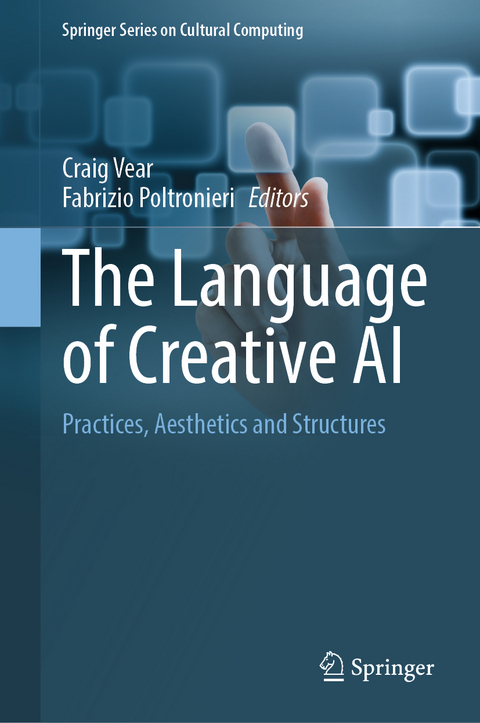
The Language of Creative AI
Springer International Publishing (Verlag)
978-3-031-10959-1 (ISBN)
This book builds on the discourse of AI and creativity and extends the notion of embedded and co-operative creativity with intelligent software. It does so through a human-centred approach in which AI is empowered to make the human experience more creative. It presents ways-of-thinking and doing by the creators themselves so as to add to the ongoing discussion of AI and creativity at a time when the field needs to expand its thinking. This will avoid over-academization of this emerging field, and help counter engrained prejudice and bias. The Language of Creative AI contains technical descriptions, theoretical frameworks, philosophical concepts and practice-based case studies. It is a compendium of thinking around creative AI for technologists, human-computer interaction researchers and artists who are wishing to explore the creative potential of AI.
Craig Vear is Research Professor at De Montfort University where he is a director of the Creative AI and Robotics Lab in the Institute of Creative Technologies. His research is naturally hybrid as he draws together the fields of music, digital performance, creative technologies, Artificial Intelligence, creativity, gaming, mixed reality and robotics. He has been engaged in practice-based research with emerging technologies for nearly three decades, and was editor for The Routledge International Handbook of Practice-Based Research, published in 2022. His recent monograph The Digital Score: creativity, musicianship and innovation, was published by Routledge in 2019, and he is Series Editor of Springer's Cultural Computing Series. In 2021 he was awarded a EURO2Million ERC Consolidator Grant to continue to develop his Digital Score research - digiscore.dmu.ac.uk Fabrizio Augusto Poltronieri is a computer artist, researcher, and curator interested in the relationships between Art, Digital Media, Design, and Technology. His expertise is in developing creative coding and its exchanges with philosophical questions. He is an Associate Professor in Creative Technologies at IOCT (Institute of Creative Technologies), De Montfort University. He holds a PhD in Semiotics from the Pontifical Catholic University of Sao Paulo (PUC/SP), Brazil. In 2011-2012, he was awarded a fellowship to develop a Postdoctoral research project on the early days of computer art at the Royal College of Art in London. One of the outcomes of this research was a major exhibition with four pioneer computer artists. This exhibition, entitled 'Primary Codes', took place in Rio de Janeiro, Brazil, in 2015. His second Postdoctoral research, at Leuphana Universitat's Gamification Lab, in Luneburg, Germany, was on how the universe of video games, the notions of gamification, and post-history affect the production of language mediated by digital apparatuses. He has been exhibiting his artworks around the globe. His work is part of important collections, such as the Victoria and Albert Museum in London. In 2021, Fabrizio was one of the artists representing the UK in the World Expo Dubai with an AI artwork.
Introduction.- Part I: Aesthetics and contexts.- On purpose: An enquiry into the possible roles of the computer in art.- Towards a symbiotic future: Art and creative AI.- Artificial intelligence and creativity under interrogation.- AI, creativity and art.- The ethics of creative AI.- Part II: Structures and frameworks.- Ecosystemic thinking: Beyond human narcissism in AI.- Embodied AI and musicking robotics.- Latent spaces: A creative approach.- Intersections of living and machine agencies: Possibilities for creative AI.- Conformed thoughts, representational systems, and creative procedures.- Part III: Practices.- Creative AI, embodiment, and performance.- Musebots and I: Collaborating with creative systems.- Composition with computer models of the brain: An alternative approach to music with artificial intelligence.- Tuning topological morphologies: Creative processes of natural and artificial cognitive systems.- Sketching symbiosis: Towards the development of relational systems.
| Erscheinungsdatum | 08.11.2022 |
|---|---|
| Reihe/Serie | Springer Series on Cultural Computing |
| Zusatzinfo | XXIX, 276 p. 96 illus., 56 illus. in color. |
| Verlagsort | Cham |
| Sprache | englisch |
| Maße | 155 x 235 mm |
| Gewicht | 619 g |
| Themenwelt | Mathematik / Informatik ► Informatik ► Betriebssysteme / Server |
| Informatik ► Software Entwicklung ► User Interfaces (HCI) | |
| Informatik ► Theorie / Studium ► Künstliche Intelligenz / Robotik | |
| Schlagworte | Artificial Intelligence • Creative AI • Embodied Interactions • Ethical Issues • Human-Computer interaction • interactive art • Language of Creative AI • latent space |
| ISBN-10 | 3-031-10959-7 / 3031109597 |
| ISBN-13 | 978-3-031-10959-1 / 9783031109591 |
| Zustand | Neuware |
| Haben Sie eine Frage zum Produkt? |
aus dem Bereich


